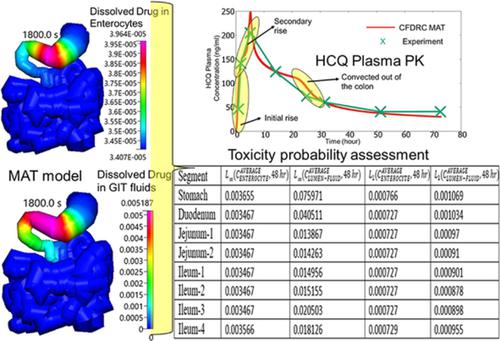当前位置:
X-MOL 学术
›
Int. J. Numer. Method. Biomed. Eng.
›
论文详情
Our official English website, www.x-mol.net, welcomes your
feedback! (Note: you will need to create a separate account there.)
A multiscale absorption and transit model for oral delivery of hydroxychloroquine: Pharmacokinetic modeling and intestinal concentration prediction to assess toxicity and drug‐induced damage in healthy subjects
International Journal for Numerical Methods in Biomedical Engineering ( IF 2.2 ) Pub Date : 2020-10-07 , DOI: 10.1002/cnm.3403 Ravishekar Kannan 1 , Andrzej Przekwas 1
International Journal for Numerical Methods in Biomedical Engineering ( IF 2.2 ) Pub Date : 2020-10-07 , DOI: 10.1002/cnm.3403 Ravishekar Kannan 1 , Andrzej Przekwas 1
Affiliation

|
Hydroxychloroquine (HCQ) is commonly used in the treatment of malaria and rheumatic diseases. Recently it has also been identified as possible therapeutic option in combating COVID‐19. However, the use of HCQ is known to induce cytotoxicity. In 2020, we developed a multiscale absorption and transit (MAT) toolkit to simulate the dissolution, transport, absorption, distribution, metabolism, and elimination of orally administered drugs in the human GIT at multiple levels. MAT was constructed by integrating the spatially accurate first‐principles driven high‐fidelity drug transport, dissolution, and absorption model in the human stomach and GIT using the recently published Quasi‐3D framework. The computational results showed that MAT was able to match the experimental concentration results better than the traditional compartmental models. In this study, we adapted MAT, to predict the pharmacokinetics of orally delivered HCQ in healthy subjects. The computational results matched the experimental concentration results. The simulated stomach and intestinal fluid and enterocyte concentrations were compared with the in vitro CC50 values. While the peak enterocyte concentrations were several orders lower than the in vitro CC50 values, the peak stomach and the intestinal fluid concentrations were only one order smaller than the in vitro CC50 values. In particular, the peak stomach and the duodenum fluid concentrations were just 3× smaller than the in vitro CC50 values. This implies that the lumen walls are much more susceptible to cytotoxicity‐based damage than the enterocyte layers. We envision that MAT can be used to optimize the dosing regimen of HCQ by maximizing its bioavailability, while simultaneously minimizing the cytotoxic damage.
中文翻译:

口服递送羟氯喹的多尺度吸收和转运模型:药代动力学模型和肠道浓度预测,以评估健康受试者的毒性和药物引起的损害
羟氯喹(HCQ)通常用于治疗疟疾和风湿病。最近,它也被确定为对抗COVID-19的可能的治疗选择。但是,已知使用HCQ会引起细胞毒性。2020年,我们开发了一种多尺度吸收和转运(MAT)工具包,以模拟人类GIT中口服给药药物在多个层面上的溶解,转运,吸收,分布,代谢和消除。MAT是通过使用最新发布的Quasi-3D框架整合空间精确的第一性原理驱动的高保真药物在人胃和GIT中的运输,溶解和吸收模型而构建的。计算结果表明,MAT能够比传统的隔室模型更好地匹配实验浓度结果。在这项研究中,我们调整了MAT,以预测健康受试者口服HCQ的药代动力学。计算结果与实验浓度结果相符。将模拟的胃,肠液和肠上皮细胞浓度与体外CC50值进行比较。虽然肠上皮细胞的峰值浓度比体外CC50值低几个数量级,但胃和肠液的峰值浓度仅比体外CC50值小一个数量级。特别是,峰值胃和十二指肠液浓度仅比体外CC50值小3倍。这意味着管腔壁比肠上皮细胞层更容易受到基于细胞毒性的损害。我们设想MAT可通过最大化其生物利用度来优化HCQ的给药方案,
更新日期:2020-12-10
中文翻译:

口服递送羟氯喹的多尺度吸收和转运模型:药代动力学模型和肠道浓度预测,以评估健康受试者的毒性和药物引起的损害
羟氯喹(HCQ)通常用于治疗疟疾和风湿病。最近,它也被确定为对抗COVID-19的可能的治疗选择。但是,已知使用HCQ会引起细胞毒性。2020年,我们开发了一种多尺度吸收和转运(MAT)工具包,以模拟人类GIT中口服给药药物在多个层面上的溶解,转运,吸收,分布,代谢和消除。MAT是通过使用最新发布的Quasi-3D框架整合空间精确的第一性原理驱动的高保真药物在人胃和GIT中的运输,溶解和吸收模型而构建的。计算结果表明,MAT能够比传统的隔室模型更好地匹配实验浓度结果。在这项研究中,我们调整了MAT,以预测健康受试者口服HCQ的药代动力学。计算结果与实验浓度结果相符。将模拟的胃,肠液和肠上皮细胞浓度与体外CC50值进行比较。虽然肠上皮细胞的峰值浓度比体外CC50值低几个数量级,但胃和肠液的峰值浓度仅比体外CC50值小一个数量级。特别是,峰值胃和十二指肠液浓度仅比体外CC50值小3倍。这意味着管腔壁比肠上皮细胞层更容易受到基于细胞毒性的损害。我们设想MAT可通过最大化其生物利用度来优化HCQ的给药方案,











































 京公网安备 11010802027423号
京公网安备 11010802027423号